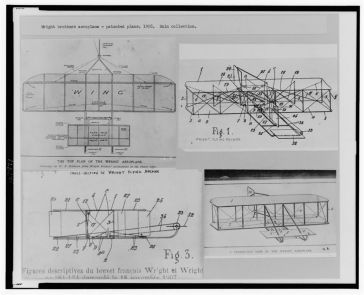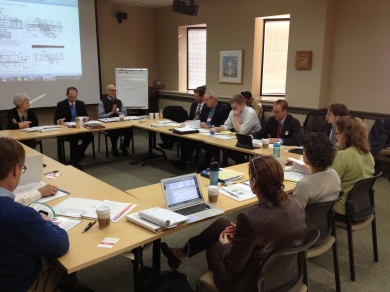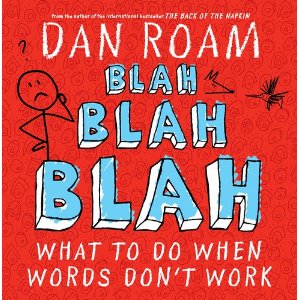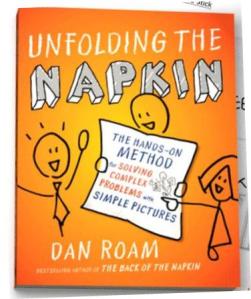
Book Review
Unfolding the napkin: The hands-on method for solving complex problems with simple pictures.
By Dan Roam.
Portfolio/Penguin, 2009. 280 p.
“If we work at it, we can imagine our way past anything thrown in our way. And once we’ve seen the solution in our mind’s eye, all we have to do is make it happen.”
I’ve enjoyed drawing pictures since I was little. Lying on the floor, face hovering next to a sheet of paper, I created the little masterpieces typical of any child’s repertoire. That’s probably part of the reason that I enjoy Dan Roam’s books about business communication. He illustrates each point with a clear, simple drawing. And he argues that more professional presentations should include their own little drawings, rather than stacking bullet points on PowerPoint slide or cramming data into spreadsheets.
This book builds on his work in The Back of the Napkin (2008) and mirrors the process of his four-day workshops: Each chapter, and each day, focuses on one aspect of his communication method: looking, seeing, imagining, and showing.
Roam developed his communication theory during 25 years of working with business leaders to develop ideas. To wit: There is no more powerful way to discover a new idea than to draw a simple picture. There is no faster way to develop and test an idea than to draw a simple picture. There is no more effective way to share an idea with other people than to draw a simple picture.
He lists “the four unwritten rules of visual problem solving”:
Rule 1: Whoever is best able to describe a problem is the person most likely to solve it. In stating the problem, I’m already alluding to a solution.
Rule 2: We can’t solve a problem that overwhelms us. To understand what we’re seeing, we need to break it into bite-size pieces. And there are only six kinds of problems out there: Who and what (shown by drawing a portrait); How much (shown by sketching a chart); Where (shown by drawing a map); When (shown by sketching a time line); How (shown by drawing a flow chart); and Why (shown by drawing a multi-variable plot on an x/ y axis.
Rule 3. Problems don’t get solved by the smartest or the fastest or the strongest. They get solved by the one who sees the possibilities. The person with the best imagination wins.
Rule 4: The more human your picture, the more human the response. Business ideas can be represented and business decisions made without software. And they must. When we need to show our ideas to others—when what really matters is getting the idea that’s in my head into yours—nothing is more powerful than our eyes, our mind’s eye, and the cognitive magic of a little hand-eye coordination.
Roam’s “look, see, imagine, show” process takes business problems apart in a consistent and repeatable way: His process serves as a default script to run the next time something nasty looms ahead: (1) let me look at the problem; (2) aha! I see what’s missing; (3) I can imagine what it will take to fix it; and (4) here, let me show you a solution.
To sharpen our critical abilities and to unblock our creative imaginations he offers the metaphor of a Swiss Army Knife. Each blade offers an approach to solving a problem. Its corkscrew, for example, has five twists, labeled S, Q, V, I, and D. Each helps us think of a problem in terms of Simple vs. elaborate; Qualitative vs. quantative; Vision vs. execution; Individual vs. comparison; and Delta (Change) vs. status quo. He illustrates each process.
Roam says we usually expect our imagination to do the mental-image gear shifting for us automatically. Most of the time that works just fine, he says. But when it comes to actively seeing possibilities, automatic is not enough. We need a manual override: a simple way to force our mind’s eye through all the gears and see all the possibilities. That’s the purpose of the SQVID approach.
Don’t get all caught up in highly polished presentations, he says. Hand-drawn pictures are compelling precisely because they are imperfect. They work because they invite interaction; human-drawn pictures work because they’re human. The easiest way we can make our problem-solving pictures interesting to look at is simply to leave them as we drew them. Mistakes and all, they make out thinking visible to anyone who looks at them, and, in the end, that’s the whole point of this book.
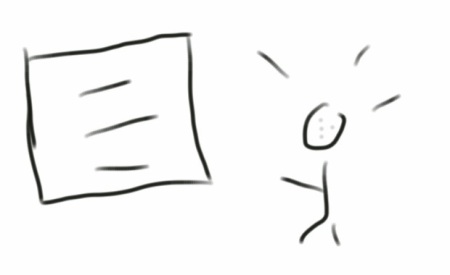



 Posted by paul baker
Posted by paul baker 